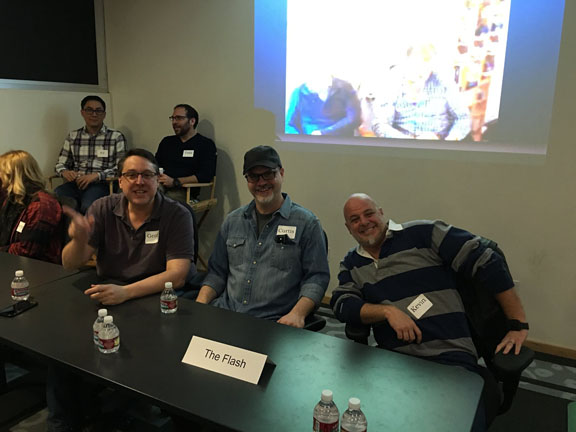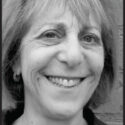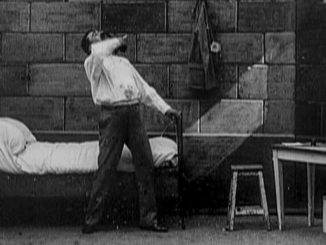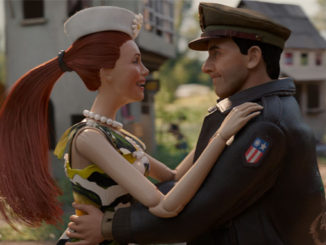
By Debra Kaufman
On Saturday, February 6, the Editors Guild Membership Outreach Committee hosted an informative panel discussing the workflow for visual effects in the editing suite, as part of the ongoing “Partnerships in the Editing Room” seminar series, which examine editorial workflow in television and the relationships of the editorial department and post producers. With Board member and The Flash VFX editor Rob Kraut as moderator, the panel consisted of editors, assistant editors, VFX editors and producers with three VFX-heavy television series: Supernatural, The Flash and Marvel’s Agents of S.H.I.E.L.D. The Guild’s Dede Allen Seminar Room was packed for the sold-out event, which began at 9:00 a.m.

Kraut asked how the different TV teams knew if they needed a VFX editor rather than let the assistant editor handle the visual effects. The Flash co-producer Geoff Garrett responded, “You’re always looking at the show as a whole. You look at complicated sequences as well as things like set extensions to determine if you need a dedicated team or not. It’s also a volume issue. You may have 150 shots for one episode, so it’s a matter of keeping up with the next episode.”
Agents of S.H.I.E.L.D. co-producer Chris Cheramie added, “The good news with bigger VFX shows is that they try to give us air dates. We adjust our post schedule based on how much time we have.”

Kraut asked Supernatural producer Todd Aronauer why the show created an in-house VFX team 11 years ago. “We decided that if the studio approved it, we’d only have to deal with what we could do within the time frame, because they were on the payroll,” he said. “We were able to eliminate budgetary conversations and just tell the best story we could, as opposed to [using] shots that were affordable or the best we could do for the episode.”
Although a lot of pre-production can go into VFX shots, Kraut noted that the visual effects plates that production shoots don’t always end up as needed in editorial, and he asked panelists how they deal with that. Aronauer agreed, noting, “You can plan it in pre-production but, by the time it gets to us, you can only work with what you were given. Sometimes you have to make a new game plan. You have to rethink it as soon as dailies and VFX come in.”
Cheramie said, “People are getting smarter, not just in understanding the process, but in knowing they have to be part of the process.” He added that having visual effects supervisor Mark Kolpack on staff is a big help; he is a big voice on the show.” Kolpack noted that his own background as an editor helps tremendously when he goes through the breakdowns. “That generates a budget, and we get the numbers from our facilities working on the show,” he says. “It ends up pretty darn close. So we get what we need in post.”

An audience member asked what a VFX editor actually does, and the conversation pivoted to Ryan Moos, VFX editor for Agents of S.H.I.E.L.D. “I’m a glorified librarian,” he joked. “I track a lot of numbers.” He commented on the “velocity” of working on a TV series: “I’ve done features as well, and the speed at which things get done in TV is remarkable,” he said.
Moos said that one of his most crucial tasks is tracking exactly what is in and out of the show. “If you miss something that’s changed on a VFX show, that can be devastating,” he maintained. Temp shots can make the job challenging, but he pointed out that he’s very collaborative with the rest of editorial, and also noted that many people use systems, such as FileMaker Pro, or other software that enables custom databases in order to track shots. “But there’s always an itch at the back of my mind that I don’t trust the numbers being spit out,” he admitted. “I check in-and-out time codes on every shot — for about 3,500 edits.”
Moos said he became a VFX editor seven years ago, after being a videogame producer. When he learned about visual effects, he developed a passion for it, and soon found mentors to help him learn and understand the process. “You get the skills by having a passion,” he said. “I enjoyed working with [plug-ins] Boris and Sapphire. I knew I wanted to do this, so I went after it.”
Kolpack noted that, without a VFX editor, it becomes a tug-of-war for assistant editors due to the added workload. “We’re able to be pro-active on every single thing with a VFX editor,” he said. “It makes the process continually flow.”

As VFX editor for The Flash, Kraut noted that things are constantly evolving. “The VFX shots are numbered and have to be tracked in a database or a spreadsheet so they are not lost in such a dynamic environment.” He pointed out that while many shows prefer to use a database program like FileMaker Pro, The Flash has built an elaborate tracking system using Google Sheets.
Supernatural has a dual numbering system, with production and VFX each keeping their own system. The series’ assistant, editor Nancy Hurley, noted that she stays in constant contact with the VFX assistant. Moos said that as Agents of S.H.I.E.L.D. picture editor Josh Charson and assistant editor Jennifer Macfarlane are editing, they are “dropping down titles of where the VFX are. By the time it gets to an early version of the shot, Sabrina [Arnold, VFX producer] and I start numbering all the VFX cuts and create a QuickTime we send to the vendors who can bid the shots,” he said. “Sabrina makes sure we are all in parity.”
The conversation turned to “pulling shots,” with Kraut asking Moos to define the term. “It goes back to pulling film from the library and taking it to the scanner,” the Agents of S.H.I.E.L.D. VFX editor explained. “Now it’s a digital pull. Avid has its own database, and I mark in and mark out with 8-frame handles, put it in a bin and number it, then export it into FileMaker and use it to generate a PDF of an EDL. Typically, facilities don’t need an image as long as you give them the correct footage metadata on an EDL, which contains the shot number. Often times, added to the shot number will be a descriptor like “-bg1” or “-fg1” to stand for “background 1” and “foreground 1.”
Supernatural VFX producer Grant Lindsay and VFX supervisor Mark Meloche, speaking to the group via Skype from their Vancouver offices, noted that their approach to pulls is constrained by timing. “We have six comp artists and three 3D artists, and we have to jump in as soon as possible,” said Meloche. “We’ll already be doing preliminary R&D work for 3D before we’ve seen a cut. Comp tends to have to wait for elements to come through. If there’s something rotoscope-intensive, we have to delay to make sure we’ll be closer to a final cut. We typically work with 10-frame handles, but often we’ll eliminate handles altogether — or do 20-frame handles to give editorial more flexibility.”
Aronauer explained that the Supernatural team has established a “short form of communication” that, with an in-house team and Meloche as the lead artist/VFX supervisor, also smoothens the process. “Sometimes our turnarounds are so quick, it’s a leap of faith,” he said. “We have our legacy effects on the show — we’ve done more beheadings than I care to think about. So we can curtail creative decisions because the effects are the same.” For the larger, render-intensive shots, he continued, getting as much information ahead of time, such as animatics and stills, can help them know which direction to go.
The Flash’s Garrett reported, “When you talk about heavy renders, you have to have those conversations early enough so you’re doing pre-animation and changes, can be made at the right stage. If they say at the end, ‘We need the spaceship to turn left, not right,’ you may not have the time to render it out. We always identify the shots that are going to be very difficult so the producers can be involved in the process early on.”
Kolpack said they do something quite similar on Agents of S.H.I.E.L.D. “We have spotting sessions with [writer] Jeff Bell,” he said. “They’ve developed a level of trust, but we can’t assume that just by making it great, it’ll be exactly what they want. We’ll look at shots and they’ll give us notes. We have blocking passes and then a sign-off. At a certain point, the train has left the station when it comes to creative changes to VFX or character animation.”
Kraut asked Meloche if having an in–house unit gives him more flexibility on Supernatural, especially with regard to shot counts. “Shot counts, no,” replied Meloche. “Shot counts are always up in the air and depend on the episode. We’ve turned around 200 shots in an episode, but if they’re very complicated we have to limit them. The push is to get as much done in the time we have. Sometimes we get off easy and other times…it’s weekend work.”
Kraut wanted to know how VFX supervisors pick the vendors to whom they send the shots. “It is like casting actors,” said Agents of S.H.I.E.L.D.’s Kolpak. “Part of what we do is to maximize each facility’s strengths. Facilities also evolve and hire new people, so I’ll see things and then give them a shot.”
Agents of S.H.I.E.L.D.’s Moos recalled getting 18 versions of an effect from one vendor. “We assigned it to another vendor and the first version came in right,” he said. “So we knew we had to give it to the [second vendor].”
The seminar, including questions from the audience, went on until past noon. To continue the discussion, or to post some of your own questions, please visit the I AM THE UNION Facebook page forum.
Stay tuned for a forthcoming announcement of the Membership Outreach Committee’s next “Partnerships in the Editing Room” series.






